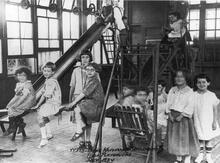Hannah Bachman Einstein
As the president of the sisterhood of Temple Emanu-El in New York, and later as president of the New York Federation of Sisterhoods, Hannah Bachman Einstein visited poor immigrants and discussed social issues with other philanthropists and volunteers, deciding that direct relief was not enough to help those in need. She took courses in sociology and began lobbying for a governmental pension for widowed mothers. In 1913, the state appointed her chair of the committee that drafted what became the Child Welfare Law of 1915, which became the model for all states’ laws on stipends for fatherless and orphaned children. She remained deeply involved with both Jewish and secular organizations, becoming the first female board member of the United Hebrew Charities and serving as president of the New York State Association of Child Welfare Boards.
Hannah Bachman Einstein was a rare example of a volunteer philanthropic activist who achieved stature in both the Jewish and gentile social welfare communities. Her lobbying efforts in Albany made her known to the larger professional and volunteer establishment, and the group of male Jewish leaders who controlled New York Jewish philanthropy allowed her into their leadership circle. She combined the skill and knowledge of a professional with the dedication of a volunteer.
Early Life and Family
Hannah Bachman Einstein was born in New York City on January 28, 1862, the first child of a German Jewish family. Her parents, Fanny (Obermeyer) and Herman Bachman, raised her in the German Reform tradition and emphasized social justice issues. They attended Temple Emanu-El, the most prominent German Jewish Reform temple in New York City. The Reform tradition became the religious form of choice for German Jews who sought ways of modernizing Judaism in the American setting. English was the language of the temple, with Friday night or (in some cases) Sunday morning as the time for the main worship service. A shortened prayer service, emulating the Protestant service, became the standard form, with the rabbi delivering a sermon in either German or English.
Hannah graduated from the New York Chartier Institute and shortly thereafter, on June 23, 1881, married William Einstein, a woolens manufacturer. The Einsteins established residence in New York City and became active members of Temple Emanu-El. The couple had two children, a son William, and a daughter Marion. In 1890, the temple created its sisterhood organization, and Einstein became an active member. In 1897, she became president, a position she held for twenty-five years.
Social Welfare, Suffrage, and Child Welfare
It was as sisterhood president that Einstein visited the homes of the newly arriving immigrants and came to the conclusion that direct relief provided by the temple was insufficient to deal with the enormous variety of social problems faced by the immigrants. In 1899, as president of the New York Federation of Sisterhoods, she gained additional experience traveling around the state.
In order to improve her own education, she took courses in 1900–190l in sociology at Columbia University and the New York School of Philanthropy. This experience confirmed her secular progressive and Jewish belief that private philanthropy and volunteer activity could not alleviate society’s ills. Government was the only agency that had the resources to do so. She joined with other reformers to lobby the New York State Legislature for widowed mothers’ pensions. One of her colleagues in this effort, with whom she worked closely, was newspaper reporter Sophie Loeb. Both Einstein and Loeb supported woman suffrage as well as social welfare issues. Between 1909 and 1915, Einstein and Loeb worked diligently for the adoption of the state law that would provide a subsidy to widowed mothers, so that they could care for their children without working outside of the home. Einstein believed strongly in the role of the family in creating healthy and contributing citizens, and she believed that motherhood was a full-time occupation.
In 1913, the state appointed her chair of its committee to investigate the issue. In the final drafting of the law, the focus became child welfare rather than mothers’ pensions. Einstein’s committee wrote the Child Welfare Law of 1915, which became the model for all states’ laws on this subject. Einstein played an active role in the administering of the law. She also lobbied within the Jewish community for the projects she supported. In recognition of her high profile in social welfare, she became the first woman to sit on the board of the United Hebrew Charities. During this period, she held the position of president of the New York State Association of Child Welfare Boards.
Hannah Bachman Einstein died in New York on November 28, 1929.
AJYB (1905–1906).
Einstein, Hannah Bachman. Papers. American Jewish Archive, Cincinnati, Ohio.
Kohut, Rebekah. My Portion (1925).
Kuzmack, Linda Gordon. Woman’s Cause: The Jewish Woman’s Movement in England and the United States, 1881–1933 (1990).




